(pdf)
Introduction
There seems to be no shortage of bad news this year with the upheaval caused by the global pandemic and the shutdown of large portions of the economy to contain the spread of the novel coronavirus. Even in normal times the U.S. tax code is difficult to navigate, which is perhaps why this year’s 1040 form instructions feature an image of a compass on the cover. Thankfully, taxpayers were given an extension on filing and paying individual income and corporate income taxes until July of this year.
The National Taxpayers Union Foundation’s annual review of the complexity and cost of the federal tax code offers some much-needed good news. Not only did the Tax Cuts and Jobs Act (TCJA) of 2017 successfully reduce income taxes for the overwhelming majority of taxpayers, it has also made it easier to file taxes. For the second consecutive year, Americans have spent less time complying with the tax laws.
The Tax Code’s Compliance Burden
According to our analysis of Office of Information and Regulatory Affairs (OIRA) data, altogether, complying with the tax code in 2019 consumed 7.854 billion hours for recordkeeping, learning about the law, filling out the required forms and schedules, and submitting information to the Internal Revenue Service (IRS).[1]

We can calculate an estimate of the value of this time burden using private sector labor costs. According to the Bureau of Labor Statistics (BLS), U.S. employers spent an average of $34.72 per hour worked on total non-federal civilian employee compensation in December 2019. (That figure includes benefits as well as wages and salaries).[2]
The opportunity cost of the billions of hours spent on taxes is equivalent to $270.9 billion in labor – valuable time that could have been spent more productively or more enjoyably was instead lost to tax code compliance. Add to that the $96.5 billion in estimated out-of-pocket costs taxpayers spent on software, professional preparation services, or other filing expenses, and the total economic value of the compliance burden imposed by the tax code can be calculated at $367.3 billion.
The good news for taxpayers is that the total number of hours spent complying with the code has now fallen for two years in a row. Last year, IRS data showed that 41 million fewer hours were spent on tax compliance in 2018, from their high in 2017 – a small but significant figure given that the previous trend had been ever-rising burdens. This tax year, an additional 169 million hours were freed up from the tiresome tax forms and associated recordkeeping. On the other hand, higher out-of-pocket expenses on both individuals and businesses drove the net compliance burden cost up by $2.79 billion to $367 billion this year.
To put the compliance burden into perspective, for every dollar forecasted in January to be raised by corporate and individual income taxes in 2019, 18 cents is spent on compliance costs. $367 billion is also:
- equivalent to 1.7 percent of last year’s GDP ($21.2 trillion);
- falls just short of the amount the Treasury paid out for net interest payments on the federal debt last year ($376 billion); and
- is nearly equal to the cost of the combined budgets of the Departments of Veterans Affairs and Agriculture ($369 billion).
Fortune publishes a yearly list of the Global 500, the largest companies in the world by revenue. Only two privately-owned businesses on the list earn more than the value of the compliance burden of the U.S. tax code: Walmart (with revenues of $514 billion) and Royal Dutch Shell ($397 billion).[3] The money lost to tax compliance is greater than the combined revenues of Amazon and Walgreens, is more than twice the revenues of AT&T, and nearly equivalent twice that of Alphabet, Google’s parent-company.
To further contextualize this immense cost, not only does the amount of time spent on taxes waste entire companies-worth of productivity, but also entire countries-worth: The U.S. federal income tax compliance burden outstrips the GDP of Hong Kong, Malaysia, and Denmark.[4]
It is also difficult to fathom just how much time is consumed by the paperwork burden of federal taxes. 7.854 billion hours is equal to almost 900,000 years. In that time, the top ten longest-running scripted U.S. television shows (from The Simpsons to CSI: Crime Scene Investigation) plus every Meet the Press and every Sesame Street, could be binge-watched more than 676,000 times.[5]
Taxpayers have access to this compliance data thanks to the Paperwork Reduction Act of 1980, which required federal agencies to track the paperwork burden imposed on citizens and businesses through forms and recordkeeping requirements. The Paperwork Reduction Act of 1995 strengthened the law and required that agencies get approval from the Office of Management and Budget for each of their compliance burdens, also known as information collections. Table 2, below, breaks out the latest compliance burden and costs associated with the IRS’s various information collections. Half of the time and cost compliance burden is due to the U.S. business income tax.
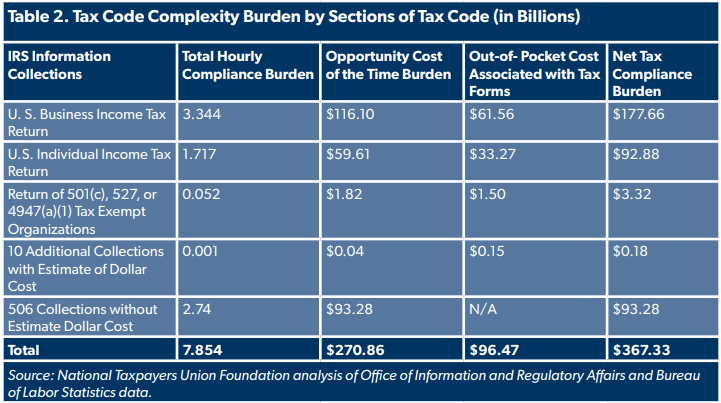
As noted in Table 2, there are currently 506 IRS paperwork collections with a listed $0 cost. In some cases, the Supporting Statements (SS) that were submitted to OMB for review of the specific collections clarify that the IRS does not expect that there are any costs. For example, “There are no capital/start-up or ongoing operation/maintenance cost” associated with Form 4562 regarding Depreciation and Amortization (imposing 448 million compliance hours).[6]
However, there are other cases where the IRS has failed to account for the estimated cost burden of a form. For example, Form 1099-B requires brokerage firms to report taxpayers’ gains or losses for stocks, bonds, and other securities. Copies are shared with the IRS and the taxpayer. The IRS estimates that the form imposes 674 million in burden hours, and tax preparers have labeled it the worst tax form because of filing delays it causes.[7] The form requires information including a description of the item sold, along with the date and value of the item when it was acquired and sold. There are often revisions that brokers need to make. Although no dollar cost is currently associated with Form 1099-B, its Supporting Statement notes that more research would be required to determine the expenses required:
As suggested by OMB, our Federal Register notice dated June 19, 2013, we requested public comments on estimates of cost burden that are not captured in the estimates of burden hours, i.e., estimates of capital or start-up costs and costs of operation, maintenance, and purchase of services to provide information. However, we did not receive any response from taxpayers on this subject. As a result, estimates of the cost burdens are not available at this time.[8]
With its vast reach, it is unsurprising that the IRS is responsible for 70 percent of the total government-wide paperwork burden estimated at 11.1 billion hours in compliance time. The next closest is the Department of Health and Human Services, imposing 1.4 billion paperwork compliance hours.[9]
Individual Income Tax
The Overall Individual Income Tax Compliance Burden
The compliance burden for the entire individual income tax (IIT) collection will be reduced by a net of 67 million hours compared to last year. Because of rising out-of-pocket costs, the net compliance burden rose from last year by $37 million to $92.9 billion.

However, the net compliance burden is still lower than before passage of the TCJA. But more importantly, the net cost per response to the IRS is down significantly (see Table 4). In 2017, the IRS estimated it would receive 153 million total forms filed under the IIT, for an average per response of $616.53. In 2019, the number of estimated responses grew to 159.3 million, but the average burden dropped to $583.06.

The IRS supporting statement for the individual income tax information collection did not include an explanation behind the net decrease in the hourly burden, but the changes ushered in by the TCJA reduced the number of people who would need to file taxes and simplified and shortened the 1040 Form (see below), saving time for people who do not file electronically. The IRS has previously estimated that 26 million fewer filers would use Schedule A because of the TCJA’s increased standard deduction. The TCJA also eliminated the Affordable Care Act’s individual mandate effective in 2019. The IRS estimates that this reduced the compliance burden by 10 million hours.
The totals in Tables 3 and 4 exclude a one-time change that was made to the IIT information collection on April 7, 2020 pursuant to the rebate checks enacted in the Coronavirus Aid, Relief and Economic Security (CARES) Act. Taxpayers who had filed in 2018 or 2019 or who received Social Security payments will receive the rebates automatically. The IRS estimates that there are an additional 14 million people who are eligible for the rebates but who do not receive Social Security. The IRS has produced an online form to allow nonfilers to submit their information, qualifying them for the rebates. The agency estimates that this will take 15 minutes to fill out, resulting in a temporary 3.5 million-hour increase in the compliance burden.[10]
1040 Forms
The basic form used by taxpayers to file their federal income taxes is the 1040. The number of lines on the 1040 was reduced significantly from 79 lines in 2017 to 23 last year. An additional line was added in this year’s version but the number of pages of instructions was pared back (see Table 6, below). An additional six new schedules were created for taxpayers with more complex returns. The Treasury Department’s Office of Tax Analysis projects that 25 percent of filers did not need to use any schedules last year.[11] In comparison, the 1040 Instructions for 2017 included a projection that 12 percent of filers would use the 1040EZ that year.

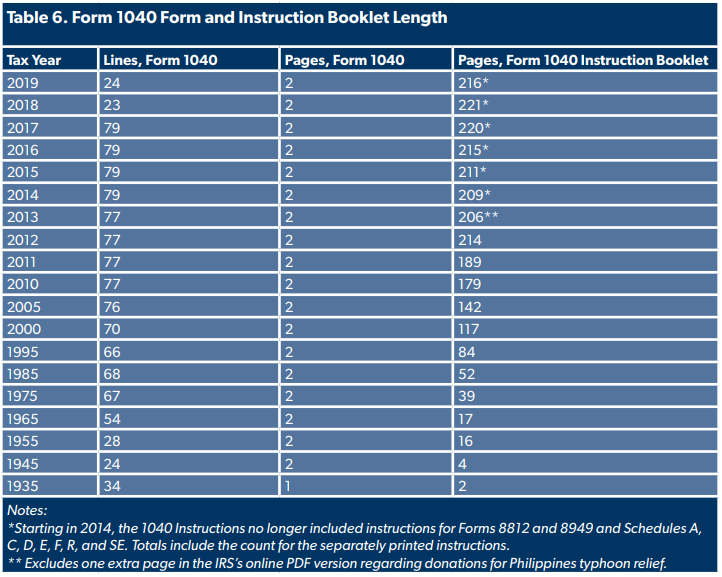
Business Income Tax Compliance Burden
The time burden and associated costs of the business income tax have continued to grow. Compared to 2018, businesses will spend an additional 187 million hours preparing and filing taxes. This applies to partnerships, corporations, and pass-through businesses. The net business tax compliance burden rose by 7 percent to $177.7 billion.


Prior to the TCJA, the U.S. had the highest combined federal, state, and local statutory corporate tax rate in the industrialized world. The TCJA dropped the federal rate from 35 percent to 21 percent. The law also eliminated the Corporate Alternative Minimum Tax, the domestic production credit, and several other general business credits. Combined, these saved filers 100,000 hours and $4 million in out-of-pocket expenses. This year, the OMB also reported that it reduced the time burden by 48.9 million hours through elimination of duplicative reporting requirements.[12]
Additional compliance savings were achieved through full expensing provisions enacted temporarily in the TCJA. This allows businesses to deduct the full value of investments from their tax liability the year of the investment. It boosts economic growth and simplifies the tax code by eliminating complicated depreciation schedules. Unfortunately, the IRS has not yet updated the compliance estimate from 2017, which showed a time burden of over 448,000,000 hours.
However, the TCJA also increased complexity through international provisions that act essentially as a complicated alternative minimum tax, including the Global Intangible Low-Taxed Income tax, the Foreign-Derived Intangible Income deduction, and the Base Erosion and Anti-Abuse Tax. The IRS supporting statement did not include a breakout of how these provisions impacted the burden totals. The statement did, however, note that technical changes also added to the burden. Economic forecasts (before the impact of the novel coronavirus) led to an increase in expected filings.
It is also important to note that there is a wide range in time burdens underlying the national average. Larger, more complex businesses will spend a lot more time calculating and reporting their taxes. For example, small corporations are estimated to spend an average of 280 hours on taxes. In comparison, corporations with assets greater than $10 million take an average of 1,255 hours.
Components of Complexity
Tax laws are codified in U.S. Code Title 26, also known as the Internal Revenue Code (IRC). The 1913 law that established the income tax was 27 pages in length. A report published that year including the “text of income tax amendments to the Constitution and Income Tax Act of 1913, plus regulations, rulings, official opinions, judicial decisions and forms” expanded the count of tax provisions to 400 pages.[13] This relatively modest start steadily grew into a colossal, bewildering web of complexity over the next century but there are signs that the trend of an ever-growing Tax Code is reversing.
The total number of pages if the Tax Code were to be printed can vary widely depending on the formatting of columns, page widths, or margins in the documents used, but NTUF has copied the PDFs of the IRC as published in 1998 and in recent years into Microsoft’s Word processor in order to use the program to generate a word count. The analysis found that over the 20-year period, the Tax Code had expanded by over 37,000 words per year, on average, reaching 3.97 million words in 2018. The version of the Code available online last year was slightly smaller, with 3.95 million words.[14] The current year’s count has further dropped to 3.89 million words. This equates to a total of roughly 6,551 pages, as printed.
A 2017 study of 300 posts made by President Trump on Twitter found that he used an average of 33 words per tweet.[15] At this Presidential Tweet Rate, it would take 117,995 tweets to add the entire 3.95 million word tax code to the social media platform. Or, if for some reason you would prefer to hear the tax code read out loud, that could take over 418 hours at Audible’s reported average reading speed of 9,300 words per hour.[16]
Since 2000, on average, 425 changes to the tax code were enacted each year (see Figure 1), ranging from a low of three in 2013 up to 797 in 2010.[17] After two successive years that saw changes enacted higher than the annual average, 2019 was a relatively quiet year with 313 tax changes. The 687 changes recorded in 2018 actually exceeded the amount in 2017 (the year the TCJA was enacted) due to the Consolidated Appropriations Act of 2018 which effected 557 revisions to the Tax Code, including technical corrections to laws pre-dating the TCJA.
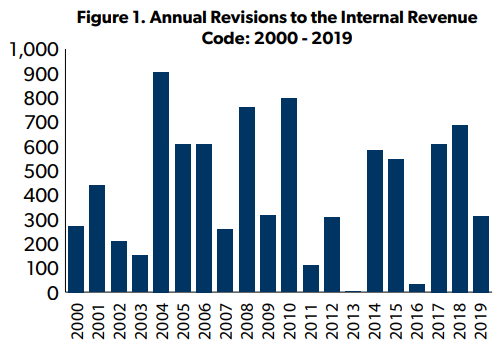
Keeping up with these annual changes and navigating through the labyrinthine laws is only part of the challenge for anyone trying to make sense of the system. The Department of the Treasury interprets the tax law in the 22 volumes of Title 26 of the Code of Federal Regulations. The most recently available version of Title 26 comprises 16,411 pages, fewer than were published in 2017.[18]
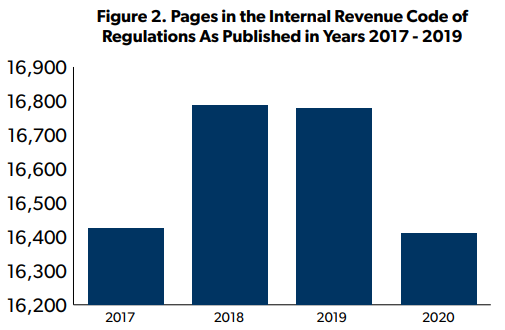
The IRS also issues tax guidance through other means and can also retroactively impose regulation:
- Revenue Rulings: “a revenue ruling is an official interpretation by the IRS of the Internal Revenue Code, related statutes, tax treaties and regulations.”
- Revenue Procedures: “an official statement of a procedure that affects the rights or duties of taxpayers or other members of the public under the Internal Revenue Code, related statutes, tax treaties and regulations and that should be a matter of public knowledge.”
- Private Letter Rulings: “a written statement issued to a taxpayer that interprets and applies tax laws to the taxpayer’s specific set of facts.” While these are written in response to taxpayer requests for information to learn about the tax consequences of a transaction before it is made, the rulings “may not be relied upon as precedent.”
- Technical Advice Memoranda: “guidance furnished by the Office of Chief Counsel upon the request of an IRS director or an area director, appeals, in response to technical or procedural questions that develop during a proceeding.”
- Notices: “a public pronouncement that may contain guidance that involves substantive interpretations of the Internal Revenue Code or other provisions of the law.”
- Announcements: “a public pronouncement that has only immediate or short-term value.”[19]
For taxpayers with complicated finances, that is a lot of information to keep track of to ensure a proper understanding of applicable tax laws, regulations, and rulings. Getting filing advice from the IRS was already problematic, as previous editions of our annual tax complexity study has warned that the IRS considers vast areas of the tax code as “out of scope” for taxpayer telephone assistance. The current quarantine and economic shutdown have worsened an already difficult season by closing down the IRS’s taxpayer clinics and forcing many federal staffers to work remotely. At the same time, the IRS is also trying to quickly distribute the economic recovery rebates included in the CARES Act.
The official delay of tax filing dates and also when certain estimated tax payments are due will help give many beleaguered taxpayers more breathing room while the economic outlook remains extremely uncertain. Additional guidance and consistent application of estimated payment deferrals would provide a life raft to struggling small businesses.
Tax Preparation Assistance Fees Dropped
In part due to tax complexity, the demand for tax assistance has increased: The IRS estimates that 90 percent of businesses and 95 percent of individual taxpayers use a paid preparer or tax software to complete their tax return and almost 90 percent of individual taxpayers e-file.[20] In another bright spot of news, the average cost for prep assistance has actually declined this year, a rare occurrence. For several years, National Taxpayers Union and National Taxpayers Union Foundation have tracked the average fee charged by H&R Block, one of the largest such preparation businesses in the country.[21] Perhaps not surprisingly, those fees have generally increased along with the system’s complexity. Due to declining costs, average fees dropped by over $10 to $231.42.
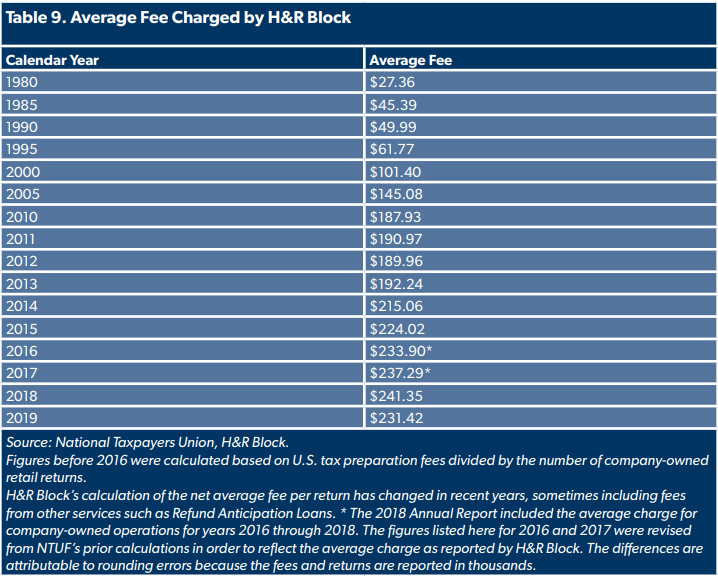
It should be noted that even after adjusting the $27.36 average fee from 1980 for inflation (equal to $90.77 in current dollars), the cost of return preparation has more than tripled since then, suggesting that the growth in tax complexity is outpacing even the technological and administrative improvements that have been made to professional preparation firms in that time.
Conclusion
The IRS projections for the 2020 filing season show that the overall time compliance burden associated with the Tax Code has fallen for the second straight year after the passage of the historic Tax Cuts and Jobs Act. That said, the costs imposed on individuals and businesses just to stay on the IRS’s good side remain enormous, swallowing up valuable time and energy that could be directed to productive economic work.
This will be a trying year for many taxpayers as the country navigates out of the three-punch combination of health, economic, and budgetary crises. Calls by some for complicated wealth tax schemes would grant the IRS expansive enforcement powers and should be resisted. On the positive side, the Tax Cuts and Jobs Act along with the Trump administration’s easing of costly regulatory burdens laid the foundation for a booming economy. Building on these successful policies will help to restore a sound economy which will in turn help to brighten the budget outlook.
[1] Office of Information and Regulatory Affairs. “Inventory of Currently Approved Information Collections.” Accessed on April 6, 2020 at https://www.reginfo.gov/public/do/PRAMain.
[2] Bureau of Labor Statistics. “Employer Costs for Employee Compensation – December 2019,” Tuesday, March 19, 2020. Retrieved from: https://www.bls.gov/news.release/pdf/ecec.pdf.
[3] Fortune. “Global 500.” Accessed April 9, 2020 at https://fortune.com/global500/. Fortune’s list also currently includes three Chinese state-owned companies whose revenues exceeded $367 billion.
[4] World Bank. “National Accounts Data, GDP (current US$).” Accessed April 10, 2020 at https://data.worldbank.org/indicator/NY.GDP.MKTP.CD?view=map&year_high_desc=trueAccessed.
[5] Wikipedia, “List of longest-running scripted U.S. primetime television series.” Accessed April 12, 2020 at https://en.wikipedia.org/wiki/List_of_longest-running_scripted_U.S._primetime_television_series. The calculation of the time of each of the series is from BingeWatch.com, accessed April 12, 2020 at https://www.bingeclock.com/.
[6] Internal Revenue Service, “Supporting Statement: Form 4562 Depreciation and Amortization (Including Information on Listed Property),” May 1, 2017. https://www.reginfo.gov/public/do/PRAViewDocument?ref_nbr=201704-1545-011.
[7] Saunders, Laura. “The Worst Tax Form,” Wall Street Journal, February 19, 2016. https://www.wsj.com/articles/the-worst-tax-form-1455877800.
[8] Internal Revenue Service. “Supporting Statement: (Form 1099-B) Proceeds from Broker and Barter Exchange Transactions,” July 25, 2017. https://www.reginfo.gov/public/do/PRAViewDocument?ref_nbr=201705-1545-021.
[9] Office of Information and Regulatory Affairs. “Inventory of Currently Approved Information Collections.” Accessed on April 6, 2020 at https://www.reginfo.gov/public/do/PRAMain.
[10] Internal Revenue Service. “CARES Act Non-substantive Change Justification,” April 7, 2020. https://www.reginfo.gov/public/do/PRAViewDocument?ref_nbr=202004-1545-008.
[11]Internal Revenue Service. “Supporting Statement: U.S. Individual Income Tax Return,” October 11, 2018. https://www.reginfo.gov/public/do/PRAViewDocument?ref_nbr=201808-1545-031.
[12] Internal Revenue Service. “Supporting Statement: U. S. Business Income Tax Returns,” January 30, 2020. https://www.reginfo.gov/public/do/PRAViewDocument?ref_nbr=201907-1545-001.
[13] Wolters Kluwer, CCH. “Fact Sheet: 100-Year Tax History: The Length and Legacy of Tax Law,” 2013. https://www.cch.com/wbot2013/factsheet.pdf.
[14] U.S. House of Representatives Office of the Law Revision Counsel, Annual Historical Archives. Accessed April 11 at https://uscode.house.gov/download/annualhistoricalarchives/pdf/1998/index.html. Additional available yearly archives since 1994 can be found by changing the year in the link. The version published on March 23, 2020 was accessed April 12, 2020 at https://uscode.house.gov/download/download.shtml.
[15] Editist. “Quantifying Trump’s Love of Adverbs and Exclamation Points,” 2018. https://editist.com/trump-adverbs-exclamations/.
[16] Commins, Karen. “Simple math about audiobook rates,” KarenCommins.com, June 13, 2011. https://www.karencommins.com/2011/06/some_simple_math_about_audiobo.html/.
[17] Office of the Law Revision Counsel. United States Code Classification Tables: 2019, U.S. House of Representatives. https://uscode.house.gov/classification/tables.shtml.
[18] U.S. Government Publishing Office. Code of Federal Regulations (Annual Edition). Accessed April 9, 2020 at https://www.gpo.gov/fdsys/browse/collectionCfr.action?selectedYearFrom=2019&go=Go.
[19] Internal Revenue Service. Understanding IRS Guidance – A Brief Primer. December 18, 2018. https://www.irs.gov/uac/understanding-irs-guidance-a-brief-primer.
[20] Internal Revenue Service. “Supporting Statement: U.S. Business Income Tax Return,” January 29, 2020. https://www.reginfo.gov/public/do/PRAViewDocument?ref_nbr=201907-1545-00. Internal Revenue “Supporting Statement: U.S. Individual Income Tax Return,” October 11, 2018. https://www.reginfo.gov/public/do/PRAViewDocument?ref_nbr=201808-1545-031.
[21] H&R Block, Annual Reports, https://investors.hrblock.com/financial-information/annual-reports.

